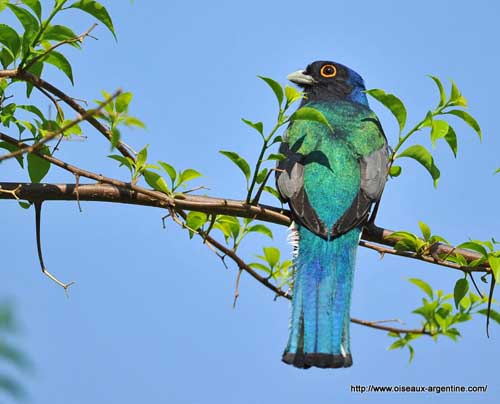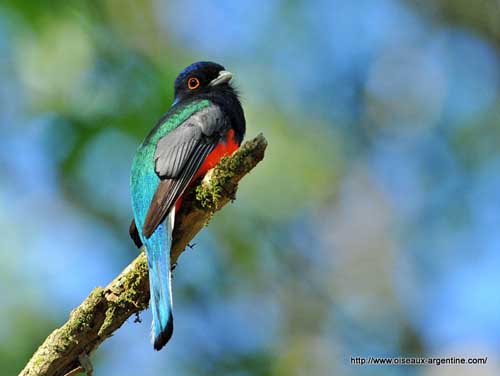
Fr: Trogon surucua
All : Surucuatrogon
Esp : Trogón Surucuá
Esp (Argentine): Surucuá común
Esp (Paraguay): Surucuá
Ital : Trogone surucua
Nd: Surucuátrogon
Sd: Surucuatrogon
Port (Brésil): Surucuá-variado
Photographers:
Philippe and Aline Wolfer
OISEAUX D'ARGENTINE
Text by Nicole Bouglouan
Sources:
HANDBOOK OF THE BIRDS OF THE WORLD Vol 6 by Josep del Hoyo-Andrew Elliott-Jordi Sargatal - Lynx Edicions, 2001 - ISBN: 848733430X
L’ENCYCLOPEDIE MONDIALE DES OISEAUX - Dr Christopher M. Perrins - BORDAS - ISBN: 2040185607
BirdLife International (BirdLife International)
Arthur Grosset's Birds (Arthur Grosset)
Wikipedia, the free encyclopaedia
Surucua Trogon
Trogon surrucura
Trogoniforme Order – Trogonidae Family
BIOMETRICS:
Length : 26 cm
Weight : 73 g
DESCRIPTION:
The Suruca Trogon has compact body and short neck. This bird is mainly arboreal and almost incapable of walking due to the very short legs. The most distinctive character of trogons is their zygodactylous feet with the toes in pairs, allowing them to grip firmly the branch where they perch for long time when resting.
The adult male of nominate race (here displayed) has royal blue crown, neck and breast, becoming turquoise-blue on nape. Forecrown, cheek and throat are blackish.
The upperparts are coppery-green, turning turquoise-green on tail. The upperwing is densely vermiculated but appears mostly grey in field.
On the underparts, the belly is pinkish-red with grey flanks. The undertail is white with black terminal bar.
The bill is greenish-grey. The eyes are dark brown, surrounded by conspicuous orange eyering. The short legs and the zygodactylous toes are grey.

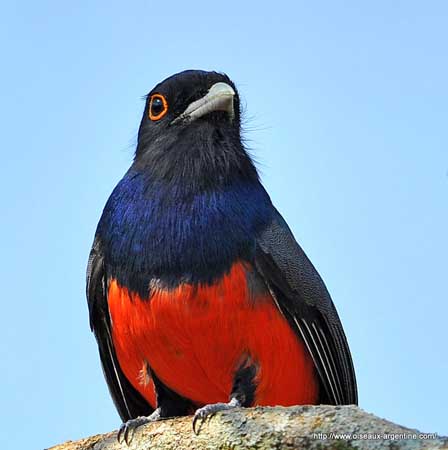
The female is dull grey with distinct narrow white bars on the upperwing. Undertail feathers are black. The three inner pairs of rectrices show white outer vanes and terminal bars.
On the head, she lacks the orange eyering, but we can see small white spots before and behind the eye.
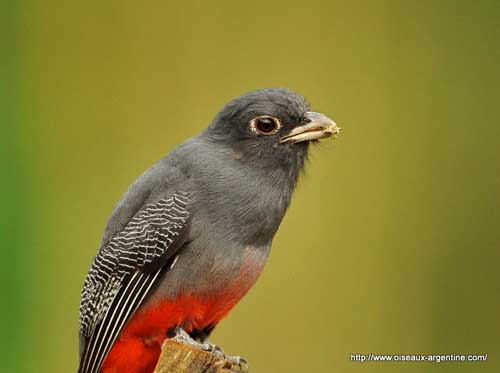
The immature female resembles adult female, whereas the immature male shows black tips to undertail feathers.
There are two subspecies:
T.s. surrucura (here described and displayed) is found in E Paraguay and NE Argentina, E to SE Brazil and probably S into Uruguay.
T.s. aurantius is found in EC and SE Brazil. This one has orange belly and yellow eyering. The female has whitish mid-belly.
VOICE: SOUNDS BY XENO-CANTO
The Suruca Trogon’s alarm call is “kiarr”. Calls can be delivered in a variety of speeds, pitches, volumes and arrangements.
The song is an ascending sequence of several “diu” or “kwa”, with lower final syllable.
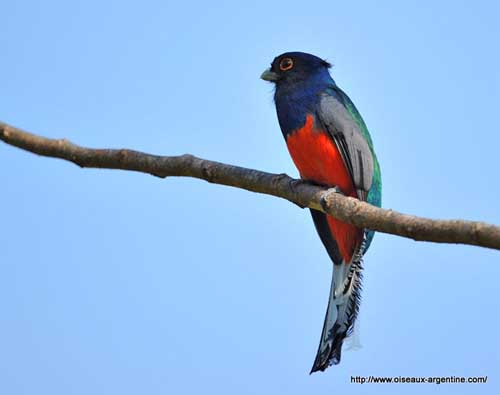
HABITAT:
The Suruca Trogon frequents the mid-storey of primary and tall secondary forests, and the semi-deciduous woodlands. This species is found in humid forests, up to 2000 metres of elevation.
RANGE:
See above in subspecies.
BEHAVIOUR:
The Suruca Trogon is an insect-eater and may also take some fruits.
It catches insects while flying, or plucks them from branches, or sallies to catch them in mid-air.
This species is solitary and arboreal, and usually feeds in the early morning and the late afternoon. The “still-perching” behaviour is an anti-predator strategy, but it is also used in predation-strategy. This bird can turn the head through 180°, like the owls.
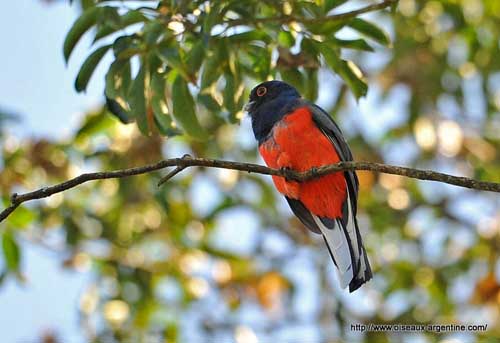
During the breeding season, the male is strongly territorial and also defends its food-resource area. It pursues other birds and also chases away the nest predators with a direct flight at the intruder accompanied with calls.
Display flights occur, during which the tail pattern is exposed. These flights are also used as aggressive signals to other males. During the displays, the pinkish-red belly is more conspicuous too.
This species is cavity nester.
Most populations appear sedentary, but during the austral winter, the southernmost birds move northwards.
FLIGHT:
The Suruca Trogon usually flies short distances due to its small territory. But its flight can be strong, swift, buoyant and efficient. Over long distance for the birds moving in winter, the flight is deeply undulating and can be slightly rocking, with bursts of rapid wingbeats.
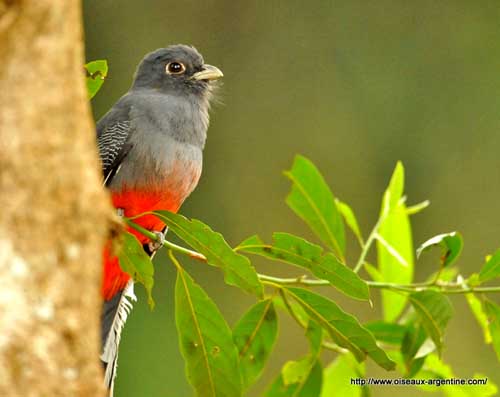
REPRODUCTION:
The breeding season occurs between September and December.
The Suruca Trogon’s nest is often situated in cavity or hole in rotting tree, in tall cactus or in thick tree-fern trunk, and sometimes in termitarium in tree.
The female lays 2-4 white eggs. Both parents incubate during about 17-19 days. The chicks are fed by adults with insects. They fledge about 20 days after hatching.
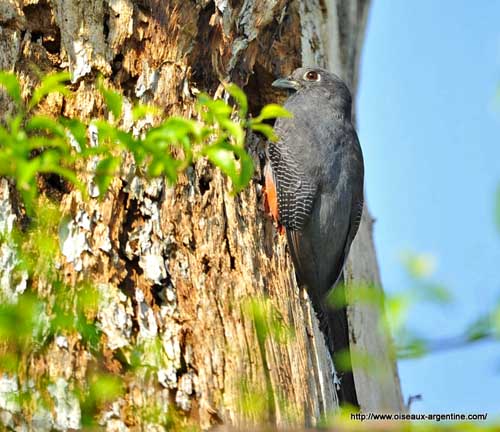
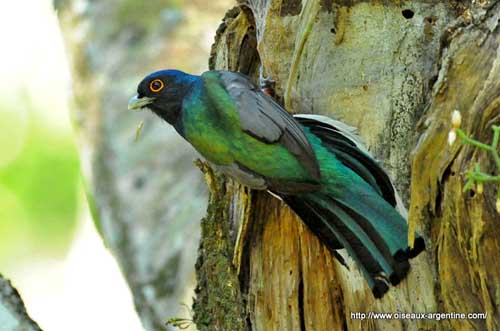
DIET:
The Suruca Trogon feeds mainly on insects and may take some fruits. It consumes Lepidoptera larvae, Diptera, grasshoppers, cicadas, moths, flying termites and ants, and spiders.
It plucks them from branches or while flying.
PROTECTION / THREATS / STATUS:
The Suruca Trogon is relatively common throughout its range, and is also found in several national parks and reserves.
This species is not currently threatened.
